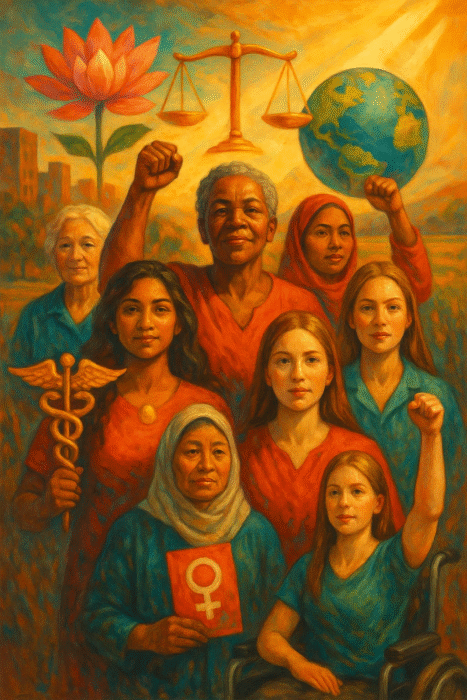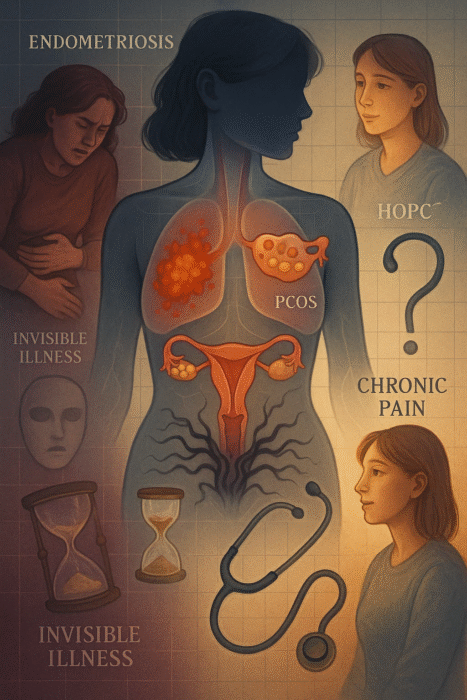Health & Well-being
Series I Part 20/16
Women’s Health Rights and Empowerment – A Bold Path to a Stronger Future
Introduction
Imagine this: According to a UNFPA report, only 55% of women worldwide have the right to make decisions about their own bodies—including access to healthcare, contraception, and reproductive freedom. This staggering number underlines a grim reality: women’s health rights are still severely limited in many parts of the world.

Women’s health rights encompass much more than access to doctors and hospitals. They include reproductive freedom, access to mental healthcare, prenatal and postnatal support, and freedom from gender-based medical bias. When women have control over their health, they are empowered to make informed choices about education, careers, family planning, and personal well-being.
A woman who has full access to healthcare becomes more confident, independent, and productive. This, in turn, contributes to the nation’s larger social, economic, and political fabric. In this blog, we explore how women empowerment is intrinsically tied to health rights, the challenges women face, and actionable solutions that can lead us to a stronger, more equal future.
The Link Between Health Rights and Women Empowerment
Why are women’s health rights the foundation of empowerment?

Health is power. Without health, women cannot dream, build, or lead. Let’s break down how health rights directly contribute to women’s empowerment:
- Bodily autonomy fuels confidence. When a woman has the right to make decisions about her own body—such as using contraception or accessing safe abortion—she gains agency. She can delay pregnancy to pursue education or choose a career before starting a family.
- Maternal healthcare enables economic participation. A healthy pregnancy and postnatal care reduce mortality and health complications. A healthy mother can work, earn, and contribute to her family’s financial stability.
- Mental health access builds strong leaders. Many women silently suffer from anxiety, depression, and burnout. When mental health support is normalized and accessible, women are better equipped to lead, innovate, and influence.
Case Study: Rwanda
Rwanda offers a shining example. After the 1994 genocide, the country prioritized universal healthcare, especially for women. Today, over 90% of Rwandan women have access to maternal health services, contributing to one of the lowest maternal mortality rates in Africa. Women’s participation in education and the economy has surged, and Rwanda now boasts one of the highest rates of female representation in government globally.
3. Key Challenges in Women’s Health Rights
While progress has been made, significant barriers still block women from full health empowerment. These challenges are layered—medical, cultural, social, and economic.
1. Reproductive Rights & Barriers
- Limited access to contraception leads to unplanned pregnancies, often derailing educational and career goals.
- In many countries, abortion is criminalized or restricted, pushing women to seek unsafe, illegal procedures.
- Prenatal care is inadequate or absent in rural or low-income communities, leading to high maternal and infant mortality.
- Cultural and religious beliefs often dictate what a woman can or cannot do with her own body.
2. Gender Bias in Healthcare

- Many female-specific conditions like endometriosis, PCOS, and chronic pain are underdiagnosed or misdiagnosed. The medical field often lacks research focused on women.
- Socioeconomic barriers—like high treatment costs and long travel distances in rural areas—limit access to proper care.
- In some cultures, women need male permission to visit doctors, especially for reproductive or gynaecological care.
3. Mental Health Stigma
- Women are twice as likely to suffer from anxiety and depression, yet their symptoms are often dismissed as “overreacting” or “being emotional.”
- Societal and workplace expectations place additional pressure on women to juggle roles of caregiver, professional, and homemaker—often with little emotional support.
- Lack of trained female therapists or culturally sensitive mental health resources worsens the problem.
Key Statistics
- 1 in 3 women experiences gender-based violence in her lifetime, often leading to PTSD or depression.
- Only 43% of countries provide free maternal healthcare.
- Women comprise only 25% of participants in global health trials, limiting treatment effectiveness for them.
(Sources: WHO, UN Women):
How Empowering Women Improves Societal Health
Women’s health doesn’t just affect women—it benefits entire communities and economies. Empowering women leads to a multiplier effect.
- Educated and healthy women raise healthier children. They ensure timely vaccinations, better nutrition, and lower child mortality rates.
- Countries with strong gender equality policies (e.g., Sweden, Norway, Finland) rank high in global happiness and development indices.
- Women in leadership roles advocate for inclusive policies, environmental awareness, and community health. Their presence creates a ripple effect, inspiring younger generations.
When a society ensures equal access to healthcare, it lays the groundwork for long-term economic growth, peace, and prosperity.
3. Steps Toward Progress – Actionable Solutions
Solving the women’s health rights crisis requires effort at multiple levels: policy, education, community, and technology.
A. Policy & Advocacy
- Governments must prioritize reproductive rights and guarantee equal access to healthcare regardless of income or geography.
- International organizations like Women Deliver, UNFPA, and Planned Parenthood are working globally to secure health rights for women.
- Enforcing laws against gender-based violence and ensuring victims receive physical and psychological support is vital.
B. Education & Awareness
- Comprehensive sex education should be mandatory in schools to reduce teen pregnancies and STD risks.
- Workplace wellness programs focused on menstrual health, maternity care, and mental well-being can retain and empower female employees.
- Public campaigns to normalize conversations around reproductive and mental health will reduce shame and misinformation.
C. Community Support & Technology
- Telemedicine platforms offer a lifeline for women in rural or underserved areas, connecting them with qualified doctors remotely.
- Women-led health groups like self-help collectives or mobile health clinics play a major role in awareness and outreach.
- Health apps and wearable technology can help women track cycles, detect anomalies, and seek preventive care early.
Conclusion
Women’s health rights are not optional—they are foundational to achieving true women empowerment and gender equality. Without access to reproductive, physical, and mental healthcare, women remain bound by limitations that restrict their growth and potential.
But there is hope. Across the world, policies are shifting, voices are rising, and communities are coming together to demand better. When we protect and promote women’s health, we are investing in a stronger, smarter, and more sustainable future for everyone.
Final Call-to-Action:
- ✨ Share this blog to spread awareness—one voice can spark a movement.
- 💬 Join the conversation: What does women’s health mean to you? Comment below
Leave a Reply